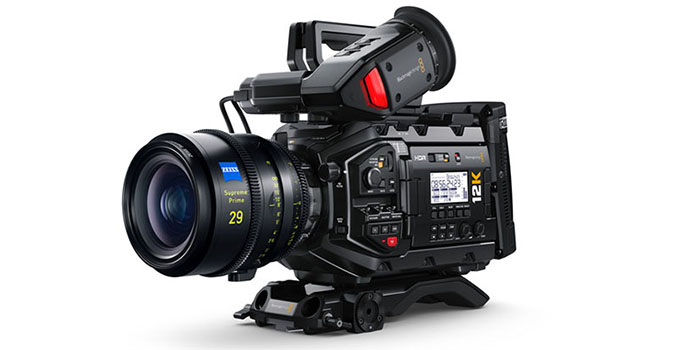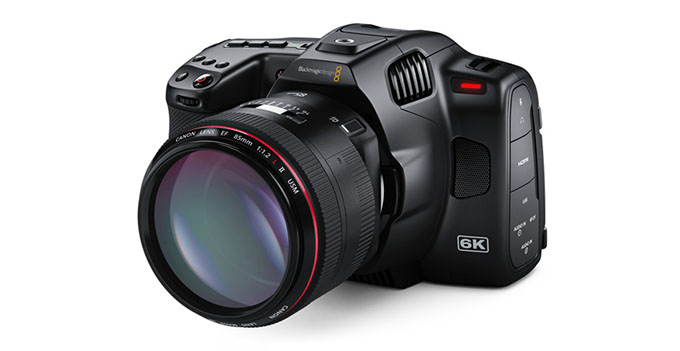
[ad_1]
Besides being made by Blackmagic, the URSA Mini Pro 12K and Pocket 6K Pro don’t seem to have many similarities. Of course, core imaging tech does have some of the same options – namely Blackmagic RAW – but the differences in body design are quite substantial.
There is also the whole 6K vs 12K discussion that needs to be had as well. It’s at least an interesting comparison even if it seems a bit absurd on the surface. If you are looking at one of these two cameras, or want to see how they might work together, you should check out this video by Of Two Lands.
Before we get into it, it is worth pointing out that both cameras deliver outstanding image quality. While there will be something of a spec comparison, if image quality is your sole decider you will be happy with either one.
Part 1: The Similarities
Being made by Blackmagic these cameras have a lot of similarities. Both have Super 35mm sensors and an EF mount (the URSA does also come with a PL mount). They have a variety of high frame rate options, internal NDs, and have very similar menus.
Part 2: The Differences
Starting with the obvious, the cameras have very different form factors. The URSA Mini Pro 12K is about twice the weight and size of the Pocket 6K Pro. This larger size makes room for a lot more function buttons and controls.
Getting into resolutions, the URSA will do up to 12K (obviously), which is 12,288 x 6,480 for DCI. The Pocket 6K hits a more modest 6144 x 3456. That’s pretty much where we are going to leave it.

Image Credit: Blackmagic Design
Each camera has a very different power option. The Pocket 6K Pro uses Sony NP-F-type L-series batteries while the URSA uses more traditional V-mount batteries.
The design is optimized for different types of filmmakers. The URSA has a larger body with controls in conventional spots for video production. It also has additional outputs such as SDI that are used in more professional situations. The Pocket 6K has a design closer to a mirrorless camera or DSLR that is well suited to handheld use.
Price is a big difference as the Pocket comes it at $2,500 and the URSA reaches $6,000.
Part 3: Pros of the Pocket 6K Pro
The 6K can shoot in ProRes. With the URSA you are limited to Blackmagic RAW. If you don’t always need raw video then having ProRes is a nice option. The Pocket also has Dual ISO which makes it better for low-light work.
The obvious advantage is the size. For travelers and solo shooters the more compact design is a huge pro.

Image Credit: Blackmagic Design
Part 4: Pros of the URSA Mini 12K
The new sensor delivers a spectacular image with unmatched detail thanks to the 12K resolution. When used properly the image can be one of the best you can get out of a modern video camera. It can even hit 60 fps in 12K and 120 fps in 8K—insane options for such a camera.
It is a “proper” camera with all the usual controls and connections that more professional workflows and productions need.
Another thing about the sensor is that it does a smart sampling which means in all the resolutions there is no cropping required. The Pocket 6K Pro on the other hand needs to do some serious cropping to get the fastest frame rates.
Part 5: How He Uses the 6K Pro
To provide some context, he uses the Pocket 6K Pro for documentary and travel videos as well as video licensing. Shooting outdoors often and traveling a lot the lighter setup is an advantage. Working handheld also is easier with the Pocket Camera’s design.
Part 6: What Would He Recommend
Right now the Pocket 6K Pro is his favorite camera because it does so much without being too expensive or too big. Add a couple accessories and it is a great run-and-gun camera. The URSA 12K is a more serious investment, but if you need the extra goodies on the larger body then it is hard to beat the specs on the URSA. The URSA is better for more traditional productions while the 6K Pro is good for solo operators or mobile shoots.
Which one of these cameras would you pick?
[source: Of Two Lands]
Order Links:
[ad_2]






